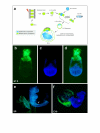Embryonic stem cells and mice expressing different GFP variants for multiple non-invasive reporter usage within a single animal
- PMID: 12079497
- PMCID: PMC116589
- DOI: 10.1186/1472-6750-2-11
Embryonic stem cells and mice expressing different GFP variants for multiple non-invasive reporter usage within a single animal
Abstract
Background: Non-invasive autofluorescent reporters have revolutionized lineage labeling in an array of different organisms. In recent years green fluorescent protein (GFP) from the bioluminescent jellyfish Aequoria Victoria has gained popularity in mouse transgenic and gene targeting regimes 1. It offers several advantages over conventional gene-based reporters, such as lacZ and alkaline phosphatase, in that its visualization does not require a chromogenic substrate and can be realized in vivo. We have previously demonstrated the utility and developmental neutrality of enhanced green fluorescent protein (EGFP) in embryonic stem (ES) cells and mice 2.
Results: In this study we have used embryonic stem (ES) cell-mediated transgenesis to test the enhanced cyan fluorescent protein (ECFP) and enhanced yellow fluorescent protein (EYFP), two mutant and spectrally distinct color variants of wild type (wt) GFP. We have also tested DsRed1, the novel red fluorescent protein reporter recently cloned from the Discostoma coral by virtue of its homology to GFP. To this end, we have established lines of ES cells together with viable and fertile mice having widespread expression of either the ECFP or EYFP GFP-variant reporters. However, we were unable to generate equivalent DsRed1 lines, suggesting that DsRed1 is not developmentally neutral or that transgene expression cannot be sustained constitutively. Balanced (diploid <-> diploid) and polarized (tetraploid <-> diploid) chimeras comprising combinations of the ECFP and EYFP ES cells and/or embryos, demonstrate that populations of cells expressing each individual reporter can be distinguished within a single animal.
Conclusions: GFP variant reporters are unique in allowing non-invasive multi-spectral visualization in live samples. The ECFP and EYFP-expressing transgenic ES cells and mice that we have generated provide sources of cells and tissues for combinatorial, double-tagged recombination experiments, chimeras or transplantations.
Figures




References
-
- Chalfie M, Tu Y, Euskirchen G, Ward WW, Prasher DC. Green fluorescent protein as a marker for gene expression. Science. 1994;263:802–5. - PubMed
-
- Chalfie M. Green fluorescent protein. Photochem Photobiol. 1995;62:651–6. - PubMed
-
- Zernicka-Goetz M, Pines J, McLean Hunter S, Dixon JP, Siemering KR, Haseloff J, Evans MJ. Following cell fate in the living mouse embryo. Development. 1997;124:1133–7. - PubMed
Publication types
MeSH terms
Substances
LinkOut - more resources
Full Text Sources
Other Literature Sources
Medical
Molecular Biology Databases
Research Materials

